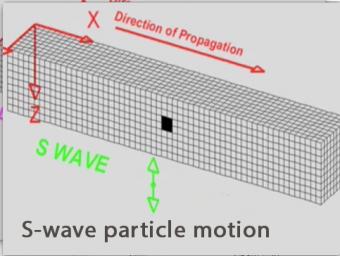
S Wave—secondary body waves that oscillate the ground perpendicular to the direction of wave travel. They travel about 1.7 times slower than P waves. Because liquids will not sustain shear stresses, S waves will not travel through liquids like water, molten rock, or the Earth’s outer core. S waves produce vertical and horizontal motion in the ground surface.
Particle motion consists of alternating transverse motion. Particle motion is perpendicular to the direction of propagation (transverse). Transverse particle motion shown here is vertical but can be in any direction. However, Earth’s layers tend to cause mostly vertical (SV; in the vertical plane) or horizontal (SH) shear motions. Material returns to its original shape after wave passes.
Animation by Larry Braile,Purdue University.